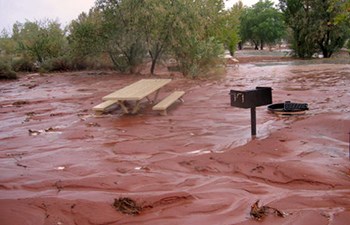
NPS General SafetyFire Safety: Fireworks and CampfiresAll wood-burning and charcoal fire use and setting, building, maintaining, attending or using open fire of any kind must stay in designated firepits and grills at campgrounds and below the high water mark on the shores of Lake Powell. Devices fueled by petroleum or LPG products are allowed in all locations. Discharge or use any kind of fireworks or other pyrotechnic devices are prohibited at all times on all federal public lands. AlcoholThe consumption or direct possession of an alcoholic beverage by a person operating a vehicle or vessel is prohibited. Glass bottles and Styrofoam are prohibited in the park. WeatherFind information on the weather, forecasts and lake levels on Glen Canyon’s Weather Page. LightningDesert thunderstorms carry the double threat of flash floods and lightning. They occur most often during the monsoons in summer. Be wary of nearby storms. Flash FloodsFlash floods are the artists who carve the intricate curves of slot canyons. They are also the assassins of anyone who may be in their paths. Be flash flood aware:
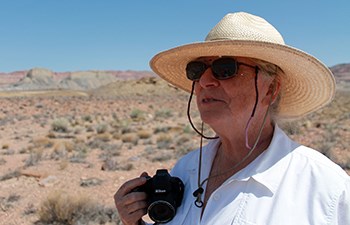
NPS Desert SafetyThe desert can be a harsh and unforgiving environment, especially if you are not accustomed to it. Drink Plenty of WaterDrink plenty of water, even when you are not thirsty, your body can lose large amounts of water without you realizing it. Be aware of balancing fluid and electrolyte levels. Have with you at least 1 gallon (4 L) of drinking water per person, per day. Take It Easy In The Hot Summer DaysDress for summer. Wear lightweight, loose fitting, light-colored clothing to reflect heat and sunlight. Minimize direct exposure to the sun. Sunburn reduces your body's ability to dissipate heat. Know the signs of heat exhaustion and heat stroke. Watch for Signs of TroubleIf you feel dizzy, nauseous, or a headache, get out of the sun immediately and drink water or sports drinks. Dampen clothing to lower body temperature. Be alert for symptoms in others. Travel Prepared to SurviveCheck road conditions before you leave AND at the nearest ranger station/visitor center if you take an unpaved road. Do not trust your vehicle or cell phone's GPS to take you on a road your vehicle is able to drive on. Carry extra drinking water in your car in case of emergency. If your car breaks down, stay with it until help comes. Backcountry TravelAvoid hiking in the heat. Hikers and backpackers need to be self-reliant and well prepared. Always plan, carry detailed maps and let someone know your plans. 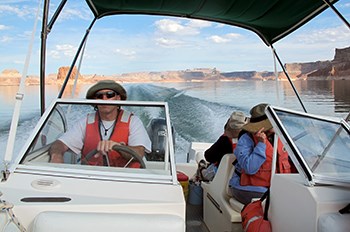
NPS/GRIT Boating SafetyStay aware of your surroundings when you are on the water. Be aware of wakes and waves that bounce back and forth between canyon walls. Slow down when passing boats. Look at the size of the wake, not the size of the boat. Depending on hull design, even relatively smaller boats can produce serious wakes. Approach large wakes at a 45-degree angle. Before going out on the water, check weather forecasts and look for storm warning flags at marinas. If a storm breaks while you are out, seek shelter in a protected cove immediately and wait until the storm passes. Lightning is also a hazard on open water. Bow riding (sitting on the top front part of the boat) is illegal unless the boat is designed for people to ride in the bow section (the bow section will have seats). All boaters must know and follow applicable state & federal boating requirements, as well as carry all required equipment on their vessels. Copies of this information are available at visitor centers. Please check our Boating page for more information or visit the U.S. Coast Guard's Boating Safety Resource Center. Additional information is available from the states of Arizona and Utah.

Carbon MonoxideThe National Park Service continues to stress the dangers of carbon monoxide (CO) and boats. This odorless, tasteless gas can kill you. The gas replaces the oxygen in your lungs and if you do not receive oxygen soon, the damage may be fatal.
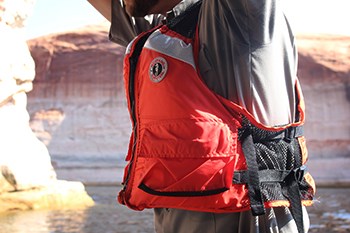
NPS Water SafetyLifejacketsPersonal flotation devices, or lifejackets, save lives. Since Lake Powell was created, almost 150 people not wearing lifejackets have drowned. Boaters are required to carry a lifejacket of proper size for every passenger in the boat. Children 12 years of age and younger must wear a Type I, II, or III U. S. Coast Guard approved lifejacket when the boat is underway. It is recommended that children always wear a lifejacket when they are around water, even if they are not on a boat. People on personal watercraft must wear a life jacket regardless of their age, as must anybody being towed by a boat (skiing, tubing, etc), and anyone using paddlecraft on the Colorado River. SwimmersThere are no lifeguards or designated swim beaches. Swim at Your Own Risk. Do Not Swim at MarinasDon't swim in marinas. Boat traffic and propeller strikes can maim or kill. Electrical faults from vessels or docks can electrocute swimmers. Lake Powell Recreational Water AdvisoryAnytime that you do recreational activities (swimming, water skiing, making sand castles, etc.) on the beaches or in the waters of Lake Powell you are strongly encouraged to follow basic hygiene practices:
Get updates and read more about Lake Powell Recreational Water Advisory.
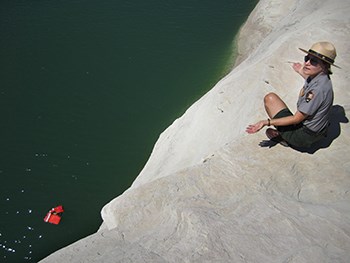
NPS Cliff JumpingSadly, there have been multiple deaths in Lake Powell due to cliff jumping. Realize if you leap from 50 feet up, you could be going almost 40 miles per hour when you hit the water. The higher the jump off spot, the faster the velocity upon impact. It is prohibited for any person to jump or dive off of rock cliffs, ledges, or man-made structures (excluding vessels).The National Park Service does not advocate or promote the activity of cliff jumping or diving regardless of the height from the water surface. For the purpose of this restriction cliff, ledge, or man-made structure is defined to mean any formation of rock or soil, or structure, or combination thereof (excluding vessels).
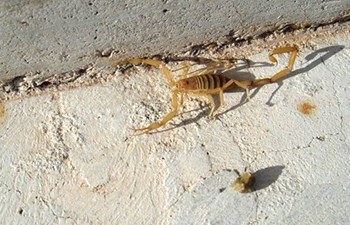
Wildlife DangersDesert creatures of all sizes can hurt you if you are not careful. Please be aware of biting and stinging animals, arachnids, and insects. A few venomous animals live in the park, including rattlesnakes, scorpions, and black widow spiders. While a scorpion sting is likely to be mild (like a bee sting), anyone bitten by a black widow spider or rattlesnake should seek medical attention as soon as possible. It is illegal to feed animals in the park. Providing wild animals food may have a negative impact. Wildlife need only the natural habitat elements - food, water, and shelter - provided by their environment. While no cases of the Zika virus have been reported in the United States, if you are planning to continue your travels south of the border, please read about this mosquito-borne threat. Hantavirus pulmonary syndrome is a potentially deadly disease spread by infected wild rodents, especially mice. People become infected when the virus becomes airborne—when dust is stirred up or nests are disturbed, especially in confined spaces. Recently, cases of this respiratory disease have been confirmed on the nearby Navajo Nation. Learn more about how to protect yourself from Hantavirus. Keep Safety in the PictureCome and capture your adventure in the park. Check out these quick tips on how to avoid photography-related hazards when visiting our national parks. 
Powell WatchAre you tired of seeing your fellow boaters dump their trash and human waste on beaches? Did you find graffiti carved on canyon walls or other damage to the landscape? Help us out on Lake Powell by being part of our neighborhood watch program. If you see any resource damage or illegal activites, send an email to our Dispatch Center, who can process accordingly and notify law enforcement. If you can, include coordinates and/or photos with your report. Send to GLCA_Dispatch_Center@nps.gov. This is an information only platform. In an emergency, call 911 or hail National Park Service on Marine Band 16. 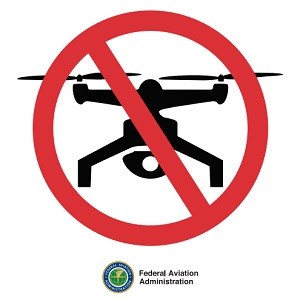
FAA graphic No Drone ZoneLaunching, landing, or operating an unmanned aircraft from or on lands and waters administered by the National Park Service within the boundaries of Glen Canyon National Recreation Area and Rainbow Bridge Monument is prohibited except as approved in writing by the superintendent. TITLE 36 CODE OF FEDERAL REGULATIONS Read more about unmanned aircraft in the national parks. |
Last updated: August 29, 2025

